Tourism in Jiangsu: Journey into Nanjing, the ancient capital of the Six Dynasties (Photo)
The team encountered a traffic jam (Photo: Feng Ganyong)
At about 5:30 a.m. on October 1, 2005, a self-driving team consisting of more than 20 small sleeping cars began to gather in the first service area of the Beijing-Tianjin-Tanggu Expressway. At around 6:30, the motorcade began to set off and headed south. Although the weather is not beautiful, it is gloomy, dark and foggy. But after all, it is the Golden Week period, and there are an unusually many vehicles, large and small, leaving Beijing on the entire highway.

Sun Yat-sen Mausoleum is crowded with people (Photo: Feng Ganyong)
The motorcade encountered its first trouble when it arrived at the entrance of the Beijing-Shanghai Expressway. The Beijing-Shanghai Expressway was closed due to fog. I saw the blocked motorcade lining up for several kilometers. Fortunately, after waiting for nearly 20 minutes, the highway began to be released in batches, so the cars that had received the trucks filed out one by one and raced on the Beijing-Shanghai Expressway like arrows unwound.

Sun Yat-sen Mausoleum Bo 'ai Fang (Photo: Feng Ganyong)
The motorcade entered Jiangsu Province through Hebei and Shandong. It encountered traffic jams and heavy rain several times on the way. After about 16 hours and more than a thousand kilometers of journey, it arrived at the first stop after the motorcade's journey, Nanjing, the capital city of Jiangsu, at about 23 o'clock that night.

Sun Yat-sen Mausoleum Gate (Photo: Feng Ganyong)
Reporters have come to Nanjing several times, especially two years ago in November 2003. As a member of the special report group on "Beautiful Nanjing, Colorful E" organized by the Foreign Affairs Office of the State Council, the reporter was very impressed by the beautiful Nanjing. On October 2, it was still rainy and rainy, but this did not affect people's enthusiasm for sightseeing on National Day. Nanjing, which is in the middle of a festival, is about to hold the 10th National Games, so it is extremely lively. According to the plan, the motorcade first arrived at Sun Yat-sen Mausoleum for a tour.

Corner in the scenic area (Photo: Feng Ganyong)
After the motorcade entered the Sun Yat-sen Mausoleum Scenic Area, everything they saw was vehicles and people coming and going. Traffic police and scenic area staff are everywhere to maintain order. It can be seen that in the face of the tourist peak during the National Day Golden Week, relevant departments in Nanjing City have made full preparations.
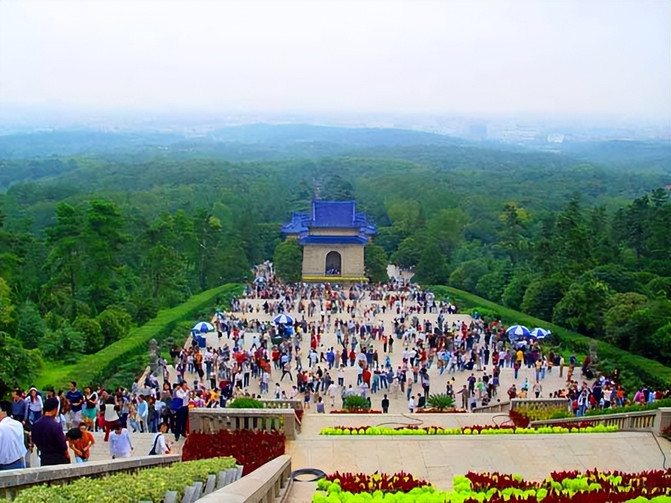
Overlooking from the Sun Yat-sen Mausoleum (Photo: Feng Ganyong)
The solemn Sun Yat-sen Mausoleum is located in the Zhongshan Scenic Area in the eastern suburbs of Nanjing. As the cemetery of Mr. Sun Yat-sen, the great pioneer of the democratic revolution, it is a must-see place for tourists coming to Nanjing for sightseeing. It enjoys a high reputation at home and abroad for its solemn historical significance, extremely high cultural value and beautiful garden scenery. Now it has become a holy place for Chinese people at home and abroad to visit.

Photo taken by Sun Yat-sen Mausoleum (Photo: Cao Qun)
On March 12, 1925, Sun Yat-sen died of illness in Beijing. In accordance with Mr. Sun Yat-sen's wishes to be buried in Zhongshan, the eastern suburbs of Nanjing, the Nanjing National Government decided to build the Sun Yat-sen Mausoleum. On May 13, 1925, the Funeral Organizing Committee approved and announced the "Example of Pattern for Soliciting the Prize for Mr. Sun Yat-sen's Mausoleum Architecture", and more than 40 types of patterns were received. After review, 10 proposals with solemn design styles won awards. Artists and architects at home and abroad showed their talents and competed to draw architectural blueprints. The bird 's-eye "alarm bell" pattern designed by 31-year-old Chinese architect Lu Yanzhi won the first prize, and he was responsible for supervising and guiding the construction of the tomb.

Foreign tourists visiting (Photo: Feng Ganyong)
On March 12, 1926, the first anniversary of Sun Yat-sen's death, the funeral organizing committee held a groundbreaking ceremony for the tomb. All provinces pledged money one after another, and overseas Chinese generously funded Sun Yat-sen Mausoleum for three years and was basically completed in the spring of 1929. On June 1 of the same year, a grand Feng 'an ceremony was held. Since then, Dr. Sun Yat-sen has been sleeping here.

Watching cultural relics (Photo: Feng Ganyong)
Sun Yat-sen Mausoleum is adjacent to Pingchuan River in front and green mountains in the back, showing a wake-up alarm type. The mausoleum building is all covered with blue glazed tiles. The archway, mausoleum gate, stele pavilion, memorial hall and tomb chamber are built on a central axis, connected by wide granite steps. They are compact, complete and spectacular.

Monument in the Monument Hall (Photo: Feng Ganyong)
The memorial hall is engraved with Sun Yat-sen's handwritten "Outline of the Founding of the People's Republic of China". In the middle is a sitting statue of Sun Yat-sen, and in the tomb is a horizontal statue of Sun Yat-sen. It combines the terrain of the mountains, highlights the natural barrier, and connects isolated small buildings into a whole with large green and wide stone steps. The pines and cypresses are green, and the mountains are green. It has both the flavor of the times and the national style. It is a large-scale group building in modern China. masterpiece.
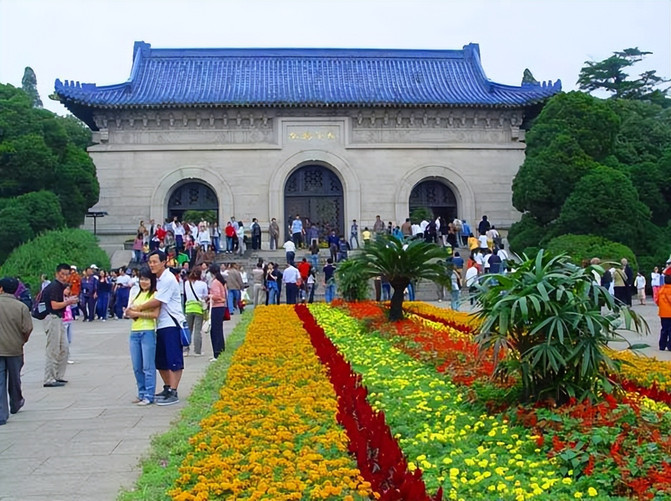
The world is the public tomb gate (Photo: Feng Ganyong)
Sun Yat-sen Cemetery has gone through many vicissitudes. During the Japanese War of Aggression against China, many scenic spots and buildings were destroyed by artillery fire. After the founding of New China, the People's Government attached great importance to the protection of Sun Yat-sen Mausoleum. When Marshal Liu Bocheng was mayor of Nanjing, he specially transported 20,000 fir trees and sycamore trees from Hunan and planted them around the tomb. In 1961, Sun Yat-sen Mausoleum was listed as a national key cultural relic protection unit.

Colorful flowers (Photo: Feng Ganyong)
For more than 40 years, Sun Yat-sen Cemetery has been continuously renovated and renovated, with a total garden area of more than 3000 hectares. Around the tomb, there are lush green and beautiful scenery. Since the reform and opening up, the management department of Sun Yat-sen Cemetery has carried out several large-scale afforestation on Zijin Mountain, and hundreds of thousands of cedar trees have been replanted alone. At the same time, new technologies and advanced management methods are continuously adopted to strengthen the protection and management of forests, pest control and fire prevention work. Today, there are vast forests and lush flowers here, and the scenery in all four seasons is beautiful.

Green trees lined with trees (Photo: Feng Ganyong)
In spring, tens of thousands of plum blossoms on Meihua Mountain compete for beauty, and more than 250 acres of Meihua Mountain float with a faint fragrance, and the number of people enjoying plum blossoms surges. In summer, wisteria hangs on the Sun Yat-sen Mausoleum Music Station to soothe the heroic spirits. Liuhui Pavilion and Zixia Lake are refreshing and refreshing, and Cemetery Avenue has become a shaded corridor, forming a cool world; in autumn, scenic spots such as Songfeng Pavilion and Baogong Tower are hidden among green leaves and yellow flowers. In Linggu Park, thousands of osmanthus flowers are fragrant everywhere; in winter, Zijin Mountain is even more majestic, and cedars in Zhongshan Mausoleum Area are especially green and straight.

In front of the gate of the Presidential Palace (Photo: Feng Ganyong)
Under the pattering drizzle, motorists paid a visit to Sun Yat-sen Mausoleum with great interest. Due to the fact that there are too many famous scenic spots to visit in Nanjing, due to limited time, the original schedule of a group visit to the Nanjing Massacre Memorial Hall in the afternoon was changed to a free arrangement. So the reporter visited the famous Presidential Palace in Nanjing with some riders.

Pavilions and watersides (Photo: Feng Ganyong)
According to data, the Presidential Palace located at No. 292 Changjiang Road, Nanjing has a history of more than 600 years. In the early Ming Dynasty, it was once the Mansion of Marquis Guide and the Mansion of King Han. In the Qing Dynasty, there were Jiangning Weaving Office, Jiangnan Governor Office, and Liangjiang Governor Office. Emperor Kangxi and Qianlong of the Qing Dynasty used this as a "palace" when they went to Jiangnan.

Landscape inside the Presidential Palace (Photo: Feng Ganyong)
In March 1853, the Taiping Army occupied Nanjing and established Tianjing as the capital. Hong Xiuquan built the large-scale Taiping Tianchao Palace (Tianwang Mansion) here. After the Qing army broke through Nanjing, it burned down the palace buildings and rebuilt the Liangjiang Governor's Office in the ninth year of Tongzhi (1870). Lin Zexu, Zeng Guofan, Li Hongzhang, Liu Kunyi, Shen Baozhen, Zuo Zongtang, Zhang Zhidong, Duan Fang and others have all served as governors of Liangjiang.
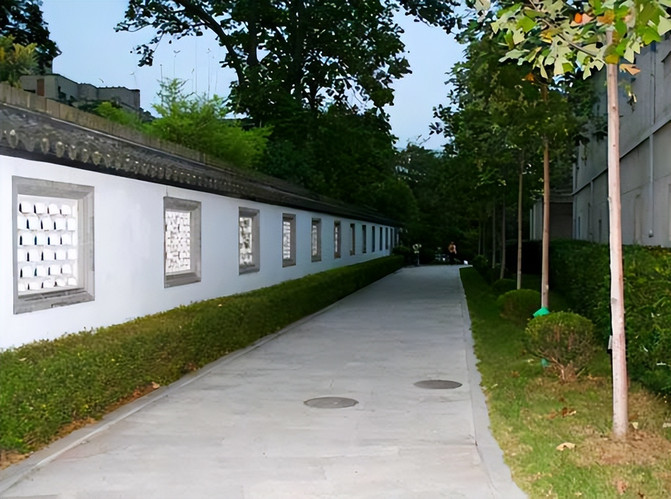
Corridor in the Presidential Palace (Photo: Feng Ganyong)
After the Revolution of 1911 broke out in October 1911, on January 1, 1912, Sun Yat-sen was sworn in as the Provisional President of the Republic of China here and formed the first republican state power in Chinese history-the Provisional Government of the Republic of China. In April 1912, the provisional government ended, and the Nanjing Left-behind Mansion headed by Huang Xing was established here; in the "Second Revolution" in 1913, it became the General Headquarters for the Yuan Army, with Huang Xing and He Haiming successively serving as commanders.
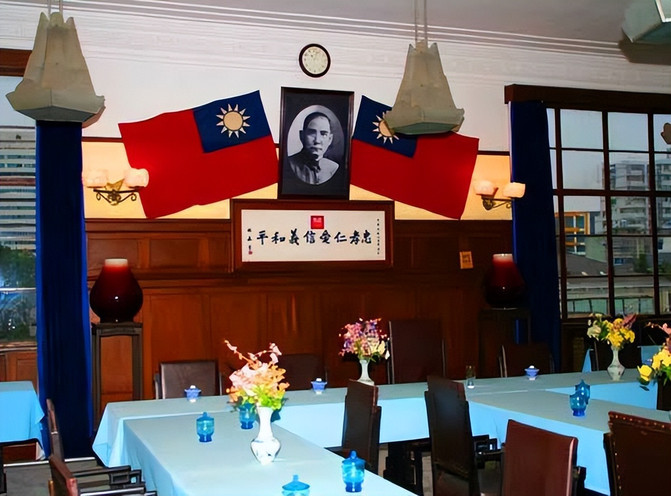
Display in the Presidential Palace (Photo: Feng Ganyong)
From 1913 to 1927, it successively became the Jiangsu Dudu Mansion, Jiangsu Governor's Office, Jiangsu General's Office, Jiangsu Supervision Office, Vice President's Office, Xuanfu Envoy's Office, Five Provincial Joint Headquarters, Zhi-Shandong Joint Office and other institutions. The chief military and political officials include Cheng Dequan, Zhang Xun, Li Chun, Qi Xieyuan, Lu Yongxiang, Feng Guozhang, Sun Chuanfang, Yang Yuting, Zhang Zongchang and others.

Presidential Palace Middle Road Exhibition Area (Photo: Feng Ganyong)
Shortly after the Nanjing National Government was established in April 1927, it moved here in September. In October 1928, the National Government implemented the "five-court system", establishing the East Courtyard (East Garden) of the National Government as the Office of the Executive Yuan, and the West Courtyard (West Garden) of the National Government as the General Staff Headquarters and the Main Budget Office of the National Government.

Presidential Palace Garden (Photo: Feng Ganyong)
By November 1937, Tan Yankai, Chiang Kai-shek, and Lin Sen had successively served as chairmen of the National Government; Tan Yankai, Song Ziwen, Chiang Kai-shek, Chen Mingshu (acting), Sun Ke, and Wang Jingwei had successively served as executive presidents; Li Jishen, He Yingqin, Zhu Peide, Chiang Kai-shek, and Cheng Qian had successively served as chiefs of general staff; and Chen Qicai was the chief controller.

Restoration of the Presidential Palace (Photo: Feng Ganyong)
After the fall of Nanjing in December 1937, the National Government successively became the 16th Division Headquarters of the Japanese Army and the Executive Yuan of the Puppet Reform Government, as well as the Legislative Yuan, Supervisory Yuan and Examination Yuan of the Puppet Wang Government; the Eastern Court of the State Government became the Puppet Ministry of Transport, the Ministry of Railways and other institutions; the Western Court of the State Government became the Puppet Military Senate.

Executive Yuan of the Presidential Palace (Photo: Feng Ganyong)
In May 1946, after the National Government returned the capital to Nanjing, it was still the seat of the National Government. East Garden became the Ministry of Social Affairs, the Ministry of Lands, the Ministry of Water Resources, and the Overseas Chinese Affairs Commission of the National Government; West Garden became the General Planning and Statistics Office, the Military Command Department of the National Government, the Military Affairs Bureau of the Presidential Office, and the Capital Garrison General Command.

Courtyard stone sash (Photo: Feng Ganyong)
On May 20, 1948, after Chiang Kai-shek and Li Zongren were elected president and vice president respectively in the "National Assembly of the Constitution", the National Government was renamed the Presidential Palace. Nanjing was liberated on April 23, 1949, and on April 24, the People's Liberation Army occupied the Presidential Palace. Since then, a new page in Chinese history has been opened.

Historical Materials Exhibition Hall (Photo: Feng Ganyong)
For nearly 50 years after the liberation of Nanjing, the Presidential Palace has been used as an office place for agencies. Since the 1980s, government agencies and units have been relocated one after another, and in 1998, the Nanjing Museum of Modern Chinese History Sites began to be built on the former site of the Presidential Palace. After careful planning and five years of construction, it had begun to take shape by 2003. Currently, the museum covers a total area of 90,000 square meters and is divided into three visiting areas.

Garden Stone Boat (Photo: Feng Ganyong)
The central area (central axis) is mainly the National Government, the Presidential Palace and its affiliated institutions; the western area is Sun Yat-sen's temporary presidential office, Secretariat and West Garden, as well as the General Staff Headquarters; the eastern area is mainly the former site of the Executive Yuan, stables and East Garden. A series of exhibition halls and historical materials displays are distributed in these three areas.

The motorcade crosses the tunnel (Photo: Feng Ganyong)
Walking into the "Presidential Palace", the reporter saw that the museum had set up eleven exhibition halls of varying sizes on the three axes of the visit, using a large number of cultural relics, historical materials and restoration displays to show the evolution of modern Chinese history. Among the large number of precious photos and cultural relics, the photos of Chiang Kai-shek and Soong Mei-ling's marriage, the "Chiang Kai-shek" bronze seal used by Chiang Kai-shek during the Anti-Japanese War, the instructions for the cost of moving the capital to Chongqing, the design of the Qingtian Bairi Banner, Soong Mei-ling's personal letter to Chiang Kai-shek during the Xi'an Incident, and Wang Jingwei's sword when he became the puppet president are rare treasures, attracting a large number of tourists to stop and watch.

Night view of Confucius Temple (Photo: Feng Ganyong)
Strolling in the courtyard of the Presidential Palace is also a pleasing enjoyment. Promenades, rockery, pavilions, water pavilions, flowers, trees, gardens, are full of unique landscapes. Close your eyes and daydream. There have been too many earth-shattering stories in Chinese history recorded here. It is also a rare experience to be able to step down-to-earth in the places where many historical predecessors have left footprints...
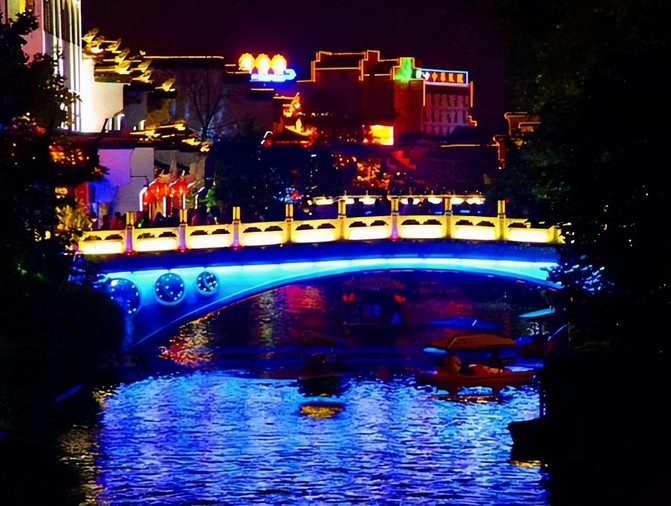
Night view of the Qinhuai River (Photo: Feng Ganyong)
The night sky in Nanjing is beautiful, and the night view along the Qinhuai River in Confucius Temple is even more charming. There are small boats flickering with candlelight in the river; the shore is brightly littered with lights.
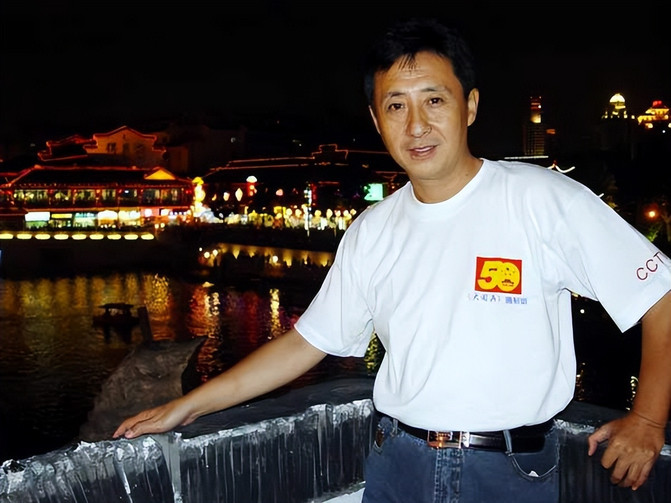
Photo taken on the Qinhuai River (Photo: Zhang Jingping)
There is an endless stream of bustling people; countless Qinhuai snacks and dishes; and brand clothing stores with different styles are gathered here. In the evening, riders came here one after another to spend their first beautiful night in Nanjing after traveling. (Photo and text: Feng Ganyong)
Previous Article:Nanjing people look at Nanjing-Zijin Villa surrounded by mountains and lakes
Next Article:Tour Shijiu Lake with my parents (4)-Lakeside Village
